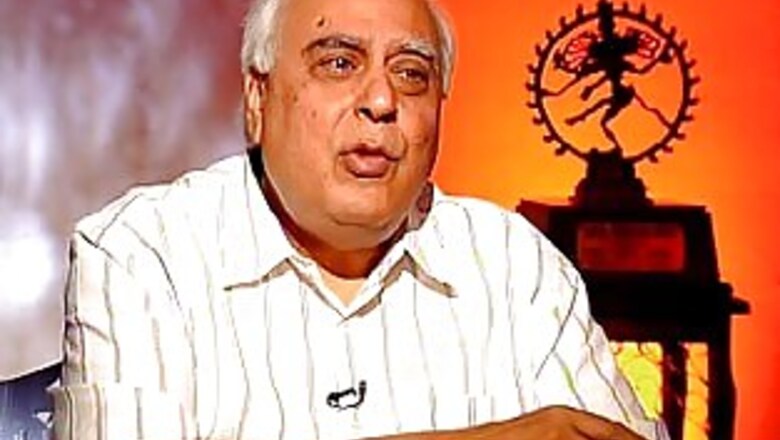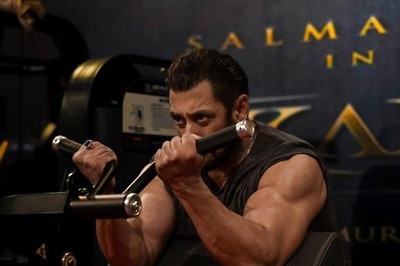
views
In 1893, the king of Baroda, Maharaja Sayajirao III, implemented compulsory primary education in a small taluka in Amralli district. In this nine-village cluster, children from the ages of seven to 12 were educated. This tiny experiment was a roaring success and was extended to all 52 villages in the district. Eventually, compulsory primary education was extended to the entire state. This was India’s first recorded stab at compulsory education.
Today Union Minister of Human Resource Development Kapil Sibal is trying to replicate the Maharaja’s endeavour through the Right to Education (RTE) Bill. While the RTE Bill was passed in 2002, it is being notified only on April 1 this year. Sibal was also the chairman of the Drafting Committee when the Bill was being formulated during the then HRD Minister Arjun Singh’s time.
Miles to go
Ever since he took charge of the ministry, Sibal has been trying to engineer radical changes in the sector. “All these years, education was about politics and not reform. I give full credit to Sibal for pushing through reforms and not politicising education,” says Madhav Chavan, founder and CEO of the educational non-profit organisation Pratham.
The Bill has the potential to change the way education is viewed in India. Education will become a fundamental right for all children aged between six and 14. RTE will require Rs. 1,72,000 crore over the next five years. R. Govinda, vice-chancellor, National University of Educational Planning and Administration, who was also on the Drafting Committee says, “RTE will change the nature of discourse. Till now whatever we have done through the Sarva Shiksha Abhiyan or other initiatives have been projects that require inputs for improving the school system. Now education has become the fundamental right so it becomes the entitlement of every child.” It is the government’s responsibility of getting children within the target group into schools. This will be legally enforceable and one can go to court against the government if denied education.
Initiatives such as the Sarva Shiksha Abhiyan have successfully put a lot of children into school. Estimates suggest that in 2001, 5 crore out of 21 crore children were out of school. Today that figure stands at a considerably lower 30-40 lakh. “State governments have done a lot for education,” says Amit Kaushik, COO, Pratham. “The first step is access but now we need to move on to the next milestone: When you set up schools, what happens then?” he asks. Kaushik was a director in the HRD ministry before joining Pratham.
So far, it is not a very happy picture. Consider the following statistics from Pratham’s Annual Status of Education Report (ASER) report: Only 50.3 percent of standard V students in government schools were able to read Standard II level text. Only 36.1 percent students were able to correctly solve a basic division problem.
The RTE has put in place a series of measures that not only aim to attack the problem of access, but also lift quality. Accessible schools within walking distance must be established. RTE mandates 25 percent reservation for children from weaker sections in Class I of all private schools. On the quality front, RTE has defined strict norms on the student-teacher ratio. So for grades 1-5 the law mandates that the student-teacher ratio will not exceed 40 for schools with more than 200 students. For those with up to 60 students, there should be two teachers at least. For grades 6-8, there should be at least one teacher for every 35 students and here schools need to have separate teachers for science and mathematics, social studies and languages. The minimum number of working days and instructional hours for teachers has been specified.
The government school system will have to be accountable. Arun Kapur, director, Vasant Valley School, New Delhi says, “In India 91 percent to 93 percent of school-going children actually go to government schools. Even if 60 percent to 70 percent of these schools improve, there will be a sea change.”
Implementation will be tough. There is little focus on learning outcomes. In a bid to de-stress children, RTE has done away with examinations at the end of the year. “In the early stages, children are still growing and their cognitive development is taking place. They are not all growing at the same pace but they can all move ahead and come together at the same stage at a later level. Therefore, don’t punish them by failing,” says Govinda.
At the age of 14, children will be awarded a certificate of completion of elementary education. Kaushik says, “RTE is very input-focussed. It says very little on the outcomes of education--what a child will have achieved from 6-14.” While RTE does say that examinations will be replaced by something called Comprehensive and Continuous Evaluation, no one is quite sure of what form that would take. Govinda clarifies the point, “This is a misleading notion that exams are out. I haven’t come across a teacher who doesn’t evaluate a student. I haven’t come across a teacher who doesn’t bother whether students are learning or not.”
PAGE_BREAK
In 2009, the ICICI Foundation looked at the public school system in India, and compared it to some of the best performing systems globally with the help of consulting firm McKinsey. It came up with four initiatives that India can take up to improve its own system: Conduct standardised assessments at national level; set up school performance management system; strengthen in-classroom support for teachers; provide more training to headmasters. There is evidence from across the world that these initiatives work. Yet, the Bill does not offer much in this direction.
The US has National Assessment of Education Progress. The UK has national assessment tests and Australia has the National Assessment Program for Literacy and Numeracy. India has ASER, which has done a lot in raising awareness about the state of primary education. But, it’s a limited survey and does not cover all schools. A national standardised assessment would be a tool for Sibal to measure the returns on his initiatives.
While the RTE stresses on teacher to student ratio, the training and the support given to teachers are as important. Dileep Ranjekar, CEO of Azim Premji Foundation, says in countries such as Brazil and Columbia the government made significant investment in teacher training and support.
Another issue is that of non-formal schools. “Once the bill comes into effect from 1st April, the government will have to provide proper primary and upper primary schools,” says educationist Vimala Ramachandran of Educational Resource Unit. “Some states like Rajasthan had
a lot of Education Guarantee Scheme (EGS) centres. These will either have to be phased out or upgraded to proper schools,” she says.
The same applies to teachers as well. Over the years, various states had deployed para-teachers, also known as barefoot teachers, shiksha karmis, gurujis and vidya sahayaks. These teachers are not well-qualified like formal teachers and are paid low salaries. For instance, in Rajasthan the minimum qualification for a para teacher can be as low as Class VIII (and Class V in case of women). In Jharkhand there are 79,000 para-teachers at the primary level while Chhattisgarh has 1,42,000 para-teachers. In states like Chhattisgarh and Madhya Pradesh, para-teachers outnumber regular teachers.
State government schools already have 5 lakh teacher vacancies. When you look at the goal of a teacher-student ratio of 1:30, the shortage becomes even more severe — 11 lakh to12 lakh teachers will have to be hired in six months. Some states don’t even have teacher training facilities.
Testing times
Some are of the opinion that Sibal’s hands are tied because of the old guard in the ministry and various committees that he inherited from his predecessor. Sibal has to contend with various lobbies within his ministry, many of whom strongly oppose private players and public-private partnership. On the other extreme are those who say that government should stay out of schools and should only fund education. “There has to be a middle path. For RTE to be successful government cannot be the only player,” says Ramachandran. “You have to be open enough to invite other players into it — corporate foundations, for-profit private sector players, not-for profit players, education trusts.” In some states, the number of private schools is increasing at a much higher rate--such as Tamil Nadu, Panjab and Haryana--there can’t be one norm for the whole country.
Whose head will roll if implementation is poor? Says Govinda, “We are trying to do several things at one time, I don’t know whether everything will be monitored because it needs a huge amount of support system that keeps track of everything--in everything from RTE, to teacher training, school education,” But monitoring is necessary. “The other important aspect is to ensure that necessary financial resources are created at the state level — including commitment to per child expenses that arise as a result of various actions to be implemented under the Act,” says Dileep Ranjekar.
The biggest challenge for Sibal will be building consensus among political leadership. “The central government doesn’t run the education system — most of it is in states with state board schools and state universities. Centre has just a small number of institutions,” says Govinda. There are already points of disagreement here — financing for instance. The state governments want all the money to come from the Centre. Sibal has just had one meeting with the education ministers of the states. Some states are in a bad fiscal situation. While states like Madhya Pradesh and Bihar have low revenues, others like Chattisgarh are better off. “He needs to have a one-to-one dialogue with each state. He has a good intention but he doesn’t want to work the intention through — to do that he needs a good group of officers working with him,” says Ramachandran.
If successful, RTE will be the high point of Sibal’s stint as HRD minister. But he needs to act fast.
(additional Reporting by N S Ramnath.)



















Comments
0 comment